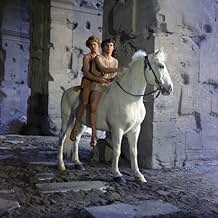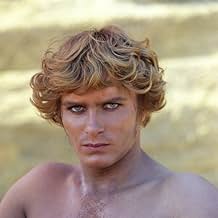Une série de contes mythiques situés au premier siècle à Rome.Une série de contes mythiques situés au premier siècle à Rome.Une série de contes mythiques situés au premier siècle à Rome.
- Réalisation
- Scénario
- Casting principal
- Nommé pour 1 Oscar
- 5 victoires et 8 nominations au total
- Trimalcione
- (as Il Moro)
- Scintilla
- (as Danica la Loggia)
- La matrona
- (as Lucia Bosé)
- Il suicida
- (as Joseph Weelher)
- Minotauro
- (as Luigi Montefiori)
Avis à la une
Fellini's movie was only loosely inspired by its literary source, Petronius's Satyricon. The nominal "plot" follows two young Roman men, the blonde Encolpio and the brunette Ascilto, introduced as rivals in love for the coquettish, androgynous slave-boy Gitone. When the latter chooses to be with Ascilto, the spurned lover Encolpio becomes involved in a series of adventures, all narrated with a familiar (to Fellini lovers), non-linear narrative structure with temporal inconsistencies and dreamlike, sudden changes of setting and mood. Encolpio attends the decadent banquet of a former slave, Trimalcione, now filthy rich. Eumolpo, an impoverished poet whom Encolpio meets on the way there, despises the wealthy man, all the more so for being rich and for having the nerve to also call himself a poet. The faint-hearted may at this point find much to object to the lasciviousness with which the banquet guests eat, drink and act lustful with one another is anything but subtle. The Trimalcione sequences felt to me like a satirical commentary on the rise of the nouveau riche in 1960s Italy. A highlight of the banquet scene is the story that the host narrates. It tells of a young widow, an oasis of cinematic calm in among the strident cacophony of the rest of the movie.
In a narrative passage which is reminiscent of the rhythm of dreams (typical of late Fellini, betraying his Jungian tendencies), Encolpio ends up captured by the pirate Lica, who takes him on board his ship. This is where the young buck meets Ascilto and Gitone again, also captives of the tyrant. At this point I was especially impressed with the extraordinary talent of Donati as a set designer. The ship wasn't built to look like a recognisable ship at all, but was rather like a symbol of one. Needless to say that no matter how abstract it was, you knew it was a ship, as its "ship-like essence" was all there! When Encolpio is beaten in a duel with Lica, he is forced to marry the pirate in a ceremony celebrated on the deck. But Lica is decapitated by some political rivals when a new Emperor takes over. "Everything changes so that it can all stay the same" is a cynical saying you still often hear in Italy. It refers to the fact that one greedy ruler will succeed another in a ruthless battle for power and privilege. That's when you realise Satyricon is a brilliant satire of modern society as well.
Encolpio and Ascilto then wander into the aristocratic home of a husband and wife who've just freed their slaves and committed suicide through bleeding themselves to death (a symbol of the death of aristocracy while the nouveau riche are getting fat?). After a threesome with a slave-girl who was left behind in the dead couple's empty home, the two young men attend a sort of sanctuary where an old man exploits the alleged healing powers of a very sick-looking, ethereal hermaphrodite child. Worshippers, lepers, cripples and sick people of all descriptions flock to ask for favours off the allegedly divine hermaphrodite. If this isn't a dark, ruthless parody of the Catholic practice of worshipping saints' relics, I don't know what is!
Subsequently captured by some soldiers, Encolpio is defeated by the Minotaur in his mythological labyrinth. The young man's life is spared when he literally talks the Minotaur out of slaying him, in a scene which is both post-modern and subtly comical. But a new humiliation is in store for Encolpio, which has him set off looking for the sorceress Enotea. Her story is told in flashback. Yet again, the prudish and faint of heart will not find the scenes of a cursed woman literally "giving birth" to fire through her vagina as their cup of tea! Though admittedly unsavoury, I also find such elements to be archetypically symbolic, and ultimately fascinating.
After visiting Enotea, Encolpio witnesses the killing of his friend Ascilto. Desperately upset, Encolpio decides to set sail for Africa on a merchant ship owned by the once-poor and bitter old poet Eumolpo, now as filthy rich and decadent as Trimalcione, whom he had once criticised for his parvenu vulgarity. When the old poet dies, he leaves a testament stating that whoever will eat his corpse will have a share of his wealth - basically, inheritance by cannibalism! Encolpio refuses the deal, while a group of greedy Roman dignitaries are shown chewing on what must obviously be the dead poet's tough old flesh, looking like so many fat cows chewing on their cuds. If a satire of a stagnant and greedy society was ever more potent and cutting than this, I would really like to hear about it!
Fellini himself defined this movie as being "Science fiction of the past". The movie's complete and intentional artifice, its occasionally obscure symbolism and gallery of grotesque portraits and strident soundtrack may not be everyone's thing. What is especially unsettling about Satyricon is that the viewer is led into a realm in which you have no idea what boundaries might be crossed. That's exactly why this is a perfect portrayal of an epoch of complete moral decadence - it drags the viewer into the exact same realm of uncertainty that the characters experience.
Reportedly a free adaptation of the now fragmentary writings of Petronius, the film also makes fleeting references to various scattered works and myths of antiquity. Even the language is a blend of various dialects and accents, effectively brewed together into a type of "primordial soup."
The film features a young man named Encolpio and his sometime friend Ascilto; both of whom seem to prefer participatory experience as a means to finding meaning in life while primarily disregarding status, power and possessions. Contrasting some of the film's more serene scenes with those of unrest and discord, patterns supportive of a life lived from a similar experiential perspective begin to emerge. Some examples are as follows:
During the "Death to the Classics" scene, the poet Eumolpo says that the arts have declined because the desire for "virtue" has been lost. Dialectical discussion and philosophy have been replaced with drinking, vice and monetary greed, thus preventing further creation of works of art at the same pinnacle of excellence as the classics.
Later when Eumolpo and Encolpio recline in the open field encased in an early morning mist, the elderly poet bequeaths to Encolpio a series of "natural" phenomena; among them mountains, rivers, clouds, love, tears, joy, sound, song and the voices of man...
During the "Matron of Ephesus" scene, a young woman mourning her deceased husband by starving to death in a cave has her chalk white face returned to its natural radiance after accepting the embrace of a handsome soldier. The moral being "...better to hang a 'dead' husband than to lose a 'living' lover..."
A politically doomed and suicidal married couple free their slaves whereupon a reference is made to the "sacred" earth. Their children are sent away to a place free from tyranny which will be "beautiful." Later, Encolpio and Ascilto arrive at the couple's elegant home and enjoy a night of revelry during which Encolpio quotes the "poet" as having said "...as for me I have always lived to enjoy the present moment as if it were the last sunrise..."
The tale of the beautiful Enotea and her subsequent punishment after she tricked the wizard who had professed his love for her seems to be a warning to remain "true" to expressions of affection.
Following what appears to be his final corruption after having abandoned his idealistic philosophy, Eumolpo proposes an interesting last will and testament. Those wishing to inherit a part of his worldly fortune are asked to devour his remains. Reflecting the hippie generation's symbolic scorn of rampant materialism during the shooting of this film, Encolpio and his friends smile and turn away, heading onward toward a new adventure.
The scenes of discord in the film appear to reflect issues related to social and political methods of enforced control over others. For example, during the banquet of Trimalcione, his sycophants eat, laugh, chant, dance, perform and throw objects on cue. While a captive at sea, Encolpio is made an object of entertainment for the pirate Lica. Later he is forced to battle a huge "minotaur' for the entertainment of a proconsul and his puppet court during the "gladiator prank" sequence.
Fellini makes strong use of colour symbolism in "Satyricon." The film opens in what appears to be a large Roman steam bath. There is the occasional sound of water dripping, and in Encolpio's tenement a seemingly wealthy group of party goers arrive on a small boat in the water, perhaps ready to go "slumming" with the poor. There is also a bluish tint to many of these early scenes as if they were being viewed through water. Later, during Trimalcione's feast, a flame red lens filter appears to overshadow the initial candle lit display giving the impression of an envelopment of fire. During the outdoor scenes on Lica's boat, the sound of the wind is recurrent and a blitz of snow appears providing a possible reference to the air element. Near the end of the film, Encolpio enters a maze by sliding in the dirt down a hillside. Following his battle with the minotaur, a dust storm blows as he attempts to make love with Arianna. Later, when he visits the elderly Enotea, she lets dirt fall from her clenched fists as if giving a silent reference to the earth element.
There are also many references to the supernatural and paranormal. Eyes stare into the camera as if to give reference to phantoms from antiquity looking at those presently alive as if to question. While Encolpio and Eumolpo have their discussion in the art gallery, a two tiered galley of soundless faces inexplicably passes by like unknown entities observing the men's conversation through a hole in the wall. There is a curious space-like object on the deck of Lica's ship. In addition, a momentary glimpse of supernatural visionary lights appear during the abduction of the "mystical" hermaphrodite who subsequently dies after having been exposed to the "light" of day. The film also presents a recurring symbolism of carved and imprinted heads eventually given great emphasis with Lica's startling decapitation. Perhaps the question is, has society become too obsessed with the intellect at the expense of the heart and the inherent value of the individual person? Perhaps not so for Fellini, as the entire film is intensely alive with a glorious blend of color; each face, each person, in Fellini's words, serving as an integral part of his artwork on film.
Finally, like the eternal wheel and his initial greeting, Encolpio's farewell is presented in front of a stone background and he is interrupted in mid sentence giving ....
On one hand, its many flaws are rather upsetting. The out-of-sync lipping (bad post-sync), the fact that the movie neither really tells a story nor evocates sensible moral or philosophical concepts... so one may say it's actually a dull movie. The violence in this movie doesn't seem to make real sense, neither does the homosexuality, neither does the "romanian decadence" portrait.
On the other hand, the scenography, the sets, the costumes and makup are among the most dazzling ones you'll ever see in cinema, and the cinematography... well... maybe the BEST one you'll ever see. I can't think of any another movie able to compete with "Satyricon"'s mindblowing cinematography. Each scene is a terrific picture, with several visual layers, extraordinary lights and focuses, a lot of invention, of visual flair, and the overall technical mastery is stunning.
The result is something mesmerizing for some, totally disgusting for others. I have to say I'm more on the mesmerized side, because I was mainly focused on the visual/meditative aspects of the movie, not on the narrative ones.
If you're really into cinema, I mean as an artistic media more than as entertainment, you MUST see "Satyricon", as it's to my sense the most *visually* outstanding movie ever made. Be prepared for some disappointment about the movie as a whole, though...
Le saviez-vous
- AnecdotesGian Luigi Polidoro registered the title Les dégénérés (1969) for his movie first. Federico Fellini fought to use the title for his movie but lost the case. Subsequently the title was changed to Fellini Satyricon.
- GaffesIn one version, Joseph Wheeler is credited as 'Joseph Weelher'.
- Citations
Soldier at Tomb: They've stolen the hanged man! While I was with you, the thief's family took him away! I know what punishment I'll get... a horrible death. Why should I wait for it? I'd rather die by my own hands.
[pulls his sword out and is about to stab himself]
Wife of Ephesus: [stops him] No! No, my dear... To lose the two men in my life, one after the other, would be too much...
Wife of Ephesus: [looks at the corpse of her husband] Better to hang a dead husband than to lose a living lover.
[the couple replace the missing hanged corpse with the corpse of her husband]
- ConnexionsEdited into Fellini: Je suis un grand menteur (2002)
- Bandes originalesThe Drums for the Niegpadouda Dance
From Anthology of Music of Black Africa
Recorded by Everest Records
Arranged by Bernard C. Salomon
Published by Arvon Music
Meilleurs choix
- How long is Fellini's Satyricon?Alimenté par Alexa
Détails
Box-office
- Budget
- 3 000 000 $US (estimé)
- Montant brut aux États-Unis et au Canada
- 1 135 943 $US
- Montant brut mondial
- 1 138 108 $US
- Durée2 heures 9 minutes
- Mixage
- Rapport de forme
- 2.35 : 1
Contribuer à cette page







































